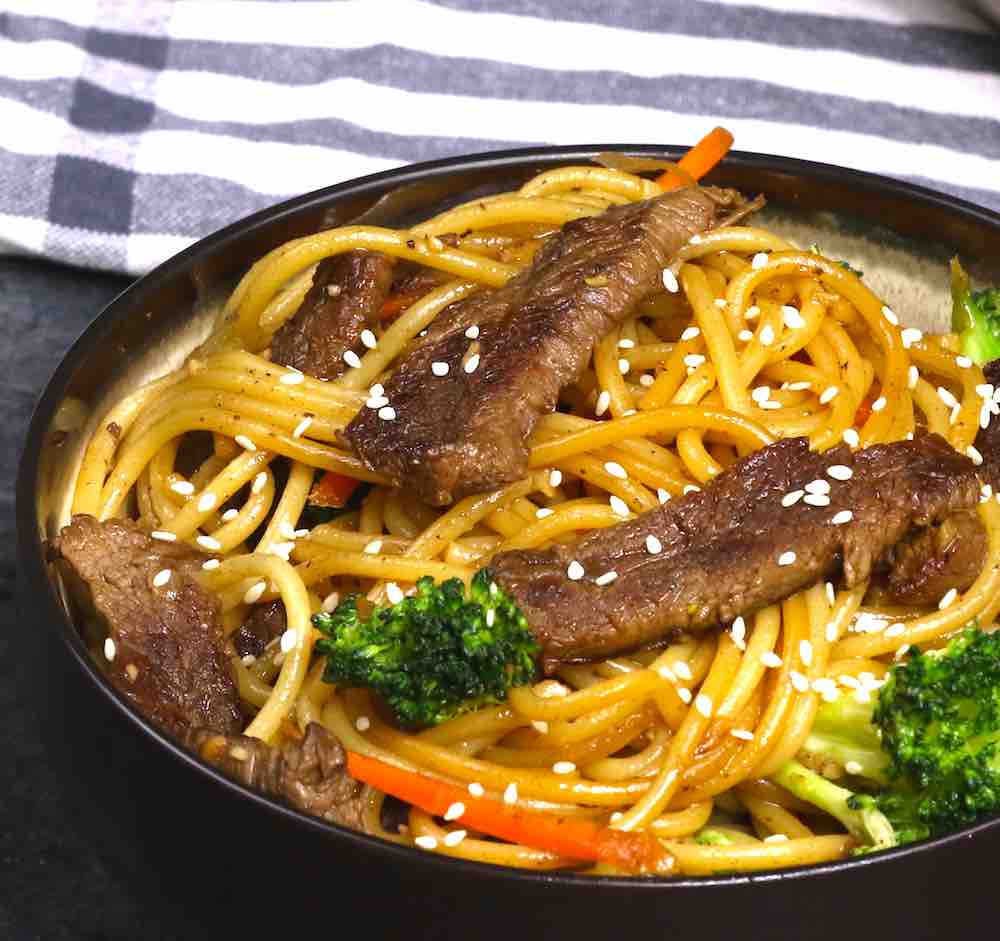Beef lo mein is a beloved Chinese-American noodle dish that has become a staple of takeout menus across the country. With its tender beef, fresh vegetables, and chewy noodles coated in a savory brown sauce, it’s easy to see why this dish is so popular. But what exactly goes into making authentic beef lo mein? Let’s take a closer look at the key ingredients that give this noodle bowl its signature flavor.
The Noodles
The foundation of any good lo mein dish is the noodles. Traditional lo mein noodles are made from wheat flour and eggs, giving them a rich, toothsome texture and beautiful golden color The noodles are usually fresh or refrigerated rather than dried, as fresh noodles have superior taste and texture that stands up well to stir-frying Some common types of Chinese noodles that may be used include Shanghai thick noodles, Hong Kong noodles, or a ramen-style Chinese noodle. Of course, spaghetti or linguine can also be substituted in a pinch! The noodles are briefly boiled until cooked al dente, then rinsed under cold water to stop the cooking process so they don’t get mushy when stir-fried.
The Beef
Thinly sliced flank steak or sirloin steak are usually the cuts of choice for beef lo mein. The beef is sliced across the grain into bite-sized strips or shreds then marinated in a mixture of soy sauce sesame oil, cornstarch, and other seasonings. This infuses flavor into the beef while also tenderizing it. The marinated beef is then stir-fried over high heat until caramelized but still tender. Getting that perfect wok sear adds tremendous flavor. Using a lean cut of beef is important so the finished dish isn’t greasy.
The Vegetables
One of the best things about beef lo mein is all the fresh vegetables that go into the mix. Popular add-ins include carrots, onions, cabbage, bean sprouts, bell peppers, broccoli, mushrooms, baby corn, snow peas, and more. The vegetables are briefly stir-fried until crisp-tender before combining everything. This retains their color and crunch. Bean sprouts are a signature ingredient, as they add great texture contrast to the noodles and beef. Vegetables can be customized based on what’s on hand or seasonal produce available.
The Sauce
The hallmark brown sauce is what brings beef lo mein together and gives it that signature flavor. There are many variations, but classic sauces often combine:
- Soy sauce – for salty, umami depth
- Oyster sauce – for extra richness
- Rice vinegar or dry sherry – for a kick of acidity
- Toasted sesame oil – for nutty aroma
- Brown sugar – for touch of sweetness
- Garlic, ginger, chilies – for spice and flavor
- Cornstarch or water – for thickening
The sauce ingredients are stirred together, then tossed with the noodles, beef and vegetables right at the end to evenly coat everything. This is what binds the dish together and makes it pop!
Traditional Add-Ins
A few other traditional ingredients may round out beef lo mein and add even more flair:
- Scallions – for color, freshness and texture
- Bamboo shoots – for pleasant crunch
- Water chestnuts – for extra crispness
- Shiitake mushrooms – for meaty flavor
- Hoisin or oyster sauce – for more umami depth
- Toasted sesame seeds – for nuttiness and crunch
These optional ingredients can further customize the dish. Add the ingredients you love most!

Chinese-style noodles and grilled beef with broccoli, onions, cabbage, and red bell peppers in a savory sauce
CONTAINS: SOY, WHEAT. Noodles Beef Cabbage Red Bell Peppers Onion
- COOKED ENRICHED CHINESE-STYLE NOODLES (SEMOLINA WHEAT, NIACIN, IRON [FERROUS SULFATE], THIAMINE MONONITRATE, RIBOFLAVIN, FOLIC ACID), WATER, FULLY COOKED GRILLED SEASONED BEEF STRIPS, WATER AND BINDER PRODUCT (BEEF, WATER, SEASONING [SALT, SPICES, MALTODEXTRIN, DEHYDRATED ONION AND GARLIC, PAPRIKA AND LEMON OIL], MODIFIED FOOD STARCH, DEXTROSE, SODIUM PHOSPHATE, CARRAGEENAN), SOY SAUCE (WATER, WHEAT, SOYBEANS, SALT, ALCOHOL, VINEGAR, LACTIC ACID), BROCCOLI, BROWN SUGAR, ONIONS, CONTAINS 2% OR LESS OF: CABBAGE, GARLIC PUREE, GINGER PUREE, RED PEPPERS, CHICKEN STOCK BASE (CHICKEN STOCK, CHICKEN FLAVOR, SEA SALT, YEAST EXTRACT, CHICKEN FAT, GARLIC POWDER, VEGETABLE STOCK [CARROT, CELERY, ONION], BAY, THYME, MARJORAM, CARROT POWDER), FOOD STARCH, SOYBEAN OIL, SUGAR, SOY SAUCE POWDER (SOY SAUCE [SOYBEANS, WHEAT, SALT], MALTODEXTRIN, SALT), NATURAL FLAVOR (WATER, NATURAL FLAVOR, SALT AND YEAST EXTRACT), NATURAL FLAVOR ENHANCER (MALTODEXTRIN, SOY SAUCE [SOYBEANS, SALT, AND WHEAT], SALT, YEAST EXTRACT), DRIED SHIITAKE MUSHROOM POWDER, NATURAL FRIED WOK FLAVOR (MALTODEXTRIN, GUM ARABIC, GRILL FLAVOR [FROM SUNFLOWER OIL], TRIACETIN, NATURAL FLAVOR), SALT, CARAMEL COLOR, NATURAL FLAVOR (WATER, NATURAL FLAVOR, SALT AND TALIN).
- CONTAINS: SOY, WHEAT.

CHEAPER AND BETTER THAN TAKEOUT – Beef Lo Mein Recipe (牛肉捞面)
FAQ
What does lo mein usually have in it?
In Cantonese cuisine, lo mein (撈麵) typically consists of boiled wheat noodles that are tossed in a sauce, such as oyster sauce, or are served with a sauce alongside. It may be accompanied by items such as wontons, char siu, or beef brisket.
What type of beef is used in lo mein?
New York strip steak is our favorite choice for this recipe, because it’s easy to work with and naturally tender. Another great cut of beef is flank steak, especially for beginner cooks. It’s super important to cut against the grain of the meat for this stir-fry, and the grain in flank steak is super obvious.
What is the difference between beef chow mein and Beef Lo Mein?
The biggest difference between chow mein and lo mein lies in the translations of their names: chow mein is fried, and lo mein is tossed.
